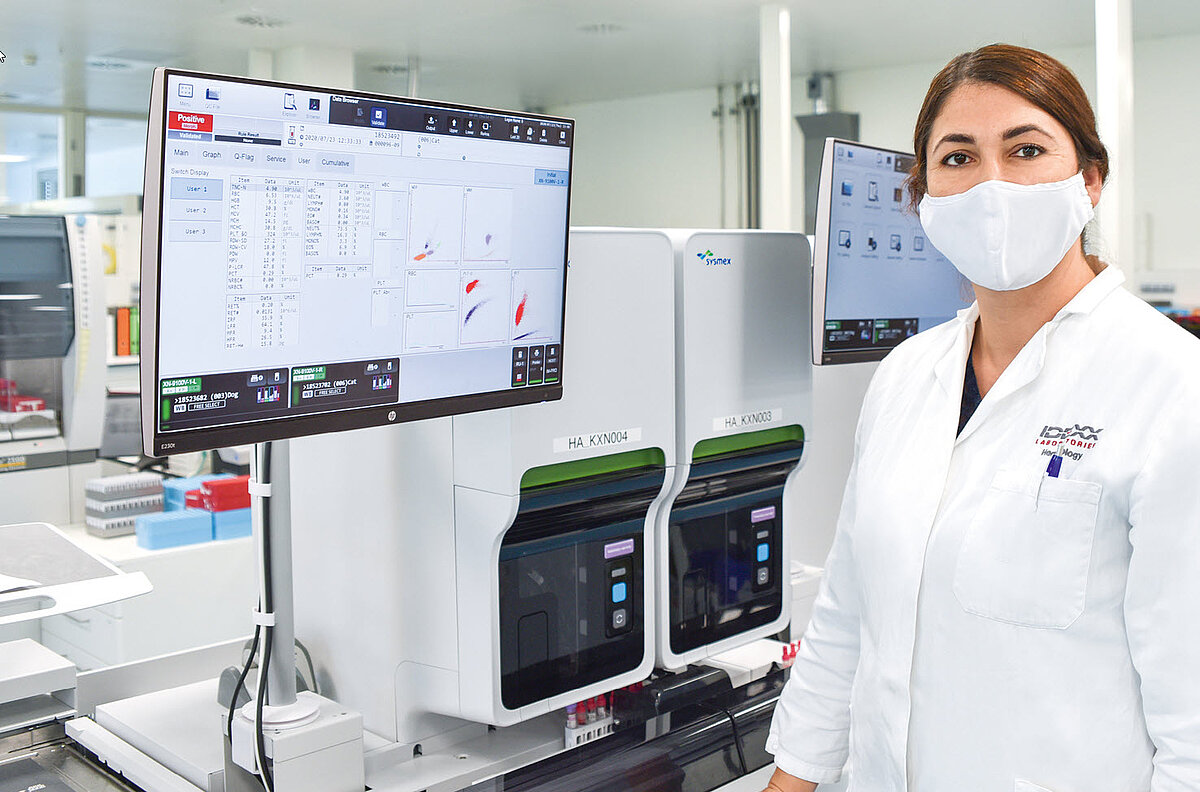The zoology of red blood cell types
XTRA ARTICLE ISSUE 2/2021
Text: Daniela Schell, Iris Weiss
IDEXX is one of the largest veterinary laboratories in Europe. Lab Manager Medine Ilbaz talks on the pitfalls of tiger blood and how the company at the Kornwestheim site is saving time with the XN-V Series.
In squid and snails they’re blue, in birds and reptiles they’re nucleated and among all living organisms the am- phibians have the largest: red blood cells show striking differences in the animal kingdom. Platelets are also two to three times larger in cats than in dogs. ‘The most unusual sample that I ever came across was that of a tiger’, recalls Medine Ilbaz, who oversees haematology and clinical chemistry at the Kornwestheim site in Baden-Württemberg, Germany, at the veterinary laboratory of global company IDEXX. ‘The scattergram resembled that of a cat and the blood levels were those of a dog. It really took us a long time to determine what animal it was’, adds the lab manager.
Mouse or elephant?
In order to stay in the know in veterinary diagnostics, you need experience above all. Medine Ilbaz has plenty of that: ‘I have worked for IDEXX for 20 years and have already analysed the blood of all animal species’, reveals the expert. ‘Of course, the most common samples we get are from dogs, cats or horses. However even with the individual breeds there are clear differences, both microscopically and in terms of values, which you have to be familiar with’. We are also often seeing exotic animals such as elephants, gorillas, sea lions or dolphins. This diversity makes work exciting for Medine Ilbaz. For the analysis of fish and amphibian samples there is one clinical pathologist in England who examines the samples.

Incredible time savings
At the beginning of the year, the IDEXX laboratory relocated its site from Ludwigsburg to Kornwestheim, because the previous premises had become too small: ‘There are now almost six times as many employees in haematology as there were 20 years ago’, explains Ilbaz, who with her team analyses 3000 to 3500 samples a day in haematology alone. ‘It usually takes one to two hours, but no more than 24 hours, for us to send the results’.
In order to cope with the growing sample volume, IDEXX has been using fully automated analysis systems from Sysmex for a long time. The laboratory management team used the relocation as an opportunity to modernise and has now switched from five individual XT-iV modules to two XN-9100V veterinary automation lines, each with four XN-V modules. Explaining the change, Ilbaz adds ‘Sysmex has really developed and improved the technology so that the XN-V Series is simply the best fit for our current requirements’. ‘I was there when the XT-iV modules were introduced, I implemented them in routine practice and took part in their validation. For us, this was the best equipment on the market at the time’, she recalls.
In veterinary medicine I am particularly fascinated by the challenge of correctly classifying different blood cells.

One drop of blood is enough
‘Thanks to the XN-V Series, we now have even fewer touch points with the samples. The reagent management system RU-20V saves us a great deal of time and the software has generally become much better. Thanks to the modular system, you can now specify even more settings yourself and usage is now much more intuitive with the touchscreen. It’s also brilliant that the XN-V still allows us to automatically measure extremely small sample volumes. Other equipment would have failed by that point’, explains Ilbaz, who also examines samples from small animals such as mice – with blood volumes of little more than ten millilitres. The XN-V Series has a low aspiration volume, meaning that sample volumes from 50 microlitres, about one drop of blood, are sufficient for automated analysis.
In clinical chemistry, Ilbaz and her team also receive around 4000 to 5000 submissions per day. Since the blood count is routinely determined in most analyses, haematology makes up the majority of day-to-day operations. ‘In most cases, the samples sent in are for preventive check-ups’, comments Ilbaz. ‘The proportion of pathological findings in veterinary laboratories is, however, much greater than in human medicine. Anaemia and leukaemia are particularly common’.
The XN-V Series gives the team time for diagnostic assessment: ‘We have a bidirectional LIS connection and no longer have to sort by animal species. We also get the results upon request. So if a full blood count is requested, then that’s exactly what happens’.
XN-9100V and RU-20V are configurations exclusively available for IDEXX.
Summary
- With the site relocation, the IDEXX laboratory in Kornwestheim switched to the XN-V Series
- The advantages of the system are the automated reagent management, intuitive operation and the low aspiration volume


